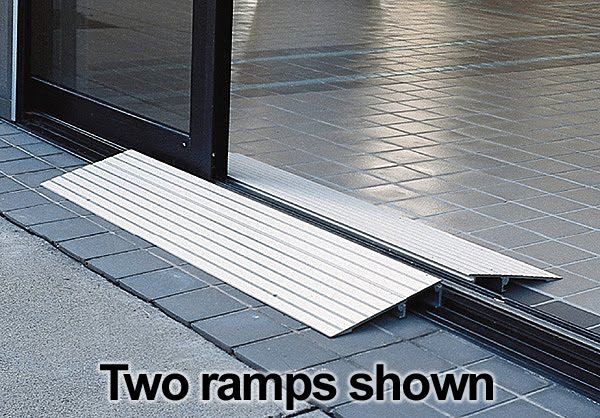A case could be made for the viability and merit of multiple accessibility ramps throughout the home. After all, when the aim is access, a ramp can be a very effective- and easy to implement- device. Before you concede on a single ram, or even one inside and one out, consider how various ramps could make a difference in the home environment.
When it comes to mobility aids and equipment, ease and access is the aim. So, it makes the most sense to utilize multiple devices and tools to make life more convenient. That said, if one ramp is good, couldn’t multiple ramps be better? Think about your home’s layout: are there steps, rises, or areas that could be made more accessible with the gentle slope of a ramp? Both mechanical and non-mechanical ramps have places throughout the home environment, and they go a long way toward reducing falls and injuries that can be debilitating and compromising to autonomy. Whether you need a little assistance or are reliant on mobility aids already, consider how ramps could improve the traffic and terrain of your home.
First, you should know that adding an access ramp to the home requires a permit from local building officials or municipalities; also, if you do not own the property but are a tenant, you will need permission from the landlord or owner before modifying the structure with ramps and other additions, unless you opt for the temporary solution of a portable ramp.
There is a case to be made for multiple accessibility ramps throughout the home, both inside and out:
Entry
Naturally, you will want to implement and install a ramp for the main entrance or exit in and out of the home. This will need to comply with recommended guidelines offered by the ADA, which can easily be found online. Specifically, you need to consider the slope and incline of the ramp to determine if it is feasible, accessible, and pragmatic for those using it in the home. Individuals that use manual wheelchairs, for instance, will benefit from less of an incline, while those with power chairs or scooters, may be able to utilize a steeper ramp, which also takes up less area and space overall. Make sure that the ramp does not present a hazard or risk to others in the home that may- or may not- use it routinely, but know that in terms of entry, a permanent, fixed ramp seems most prudent.
Vehicle
If you have physical challenges that create issues when you want to drive or ride in your vehicle, consider how a ramp can help. There are portable ramps as well as lifts that are designed for individuals with mobility limitations who want to get back behind the wheel of their car or truck. These lifts often can be folded up and placed inside the vehicle, providing versatility and convenience wherever you go!
Porch
Many with physical limitations miss spending time outside, such as on their porch, which may be difficult due to steps, stairs, or locale. Portable ramps or fixed ramps- depending on the porch configuration and location, can solve this conundrum and allow entry to the porch, patio, or other outdoor space, providing full access and autonomy at home.
Thresholds
Even out the bumps and borders inside the home with threshold ramps. These are small and easy to install, providing a smooth terrain over doorways and entries that can create an unobstructed path for those with a physical limitation or disability. Talk to a mobility dealer to learn more about these clever and necessary fixtures.
Yard and Garden
Miss spending time in your yard and garden? Consider the perks of installing ramps around your landscape so that you can enjoy full access to outdoor spaces. Worried about modifying the property to accommodate a fixed, mechanical ramp? Instead, opt for a portable ramp that can be moved and modified to suit your needs.
If you plan to take a DIY approach to construct ramps throughout the home, make sure to follow the recommended ADA guidelines to ensure the ramp is up to code and safe for regular use. All things considered, it may be most practical to buy ramps from mobility vendors for ease and satisfaction.
Multiple accessibility ramps are going to make the home more convenient, safe, and accessible- which all contribute to your own overall autonomy, independence, and quality of life. Choose from permanent ramps that alter the layout of the home to simple portable solutions that can go wherever you go. A lot of factors come into play when figuring out the best ramps for a distinct living environment- it can be quite insightful and helpful to talk to an industry professional. Consider the difference ramps will make throughout your home and talk to the mobility experts at Pacific Mobility to learn more.
President, Husband, Father, Grandfather Graduate of UC Davis- Bio Sci Major- Go Aggies! Jeff has extensive experience in all of Pacific Mobility’s products and services, and specializes in accessibility products as well as stairlifts, ceiling lifts and custom wheel chairs. His hobbies include spending time with family, gardening, mountain biking, exercising and off road motorcycle riding.
24 years as Owner/President of Pacific Mobility Center – selling, installing, and servicing stairlifts, porch lifts, ceiling lifts, pool lifts, handicap ramping, specialty wheelchairs, scooters, power wheel chairs, and other power mobility devices
Certified Environmental Access Consultant since 2008
Licensed General Contractor since 1998
Certified Aging in Place Specialist since 2016
Board Member for Home Access Professionals
Member of Association of Members of the Accessibility Equipment Industry (AEMA)




